-
Car Reviews
- All reviews
- Midsize SUVs
- Small cars
- Utes
- Small SUVs
- Large SUVs
- Large cars
- Sports SUVs
- Sports cars
- Vans
Latest reviews
- Car News
-
Car Comparisons
Latest comparisons
- Chasing Deals
The most capable, off-road-suited Prado ever arrives with the new 250 Series, but is the Altitude worthy of its lofty name?
The Altitude is the rockstar of the new Toyota LandCruiser Prado 250 range. Toughest looking, most capable off-road and – by being five-seat only – has a less awkward and clumsy boot space than three-row Prados.
But let’s not beat around the bush. The new Prado has copped criticism from all corners: press, public, prospective buyers and owners alike. It’s such a halo car for Toyota (and been 15 years between generations), an all-new model was always going to stir emotions and opinions.
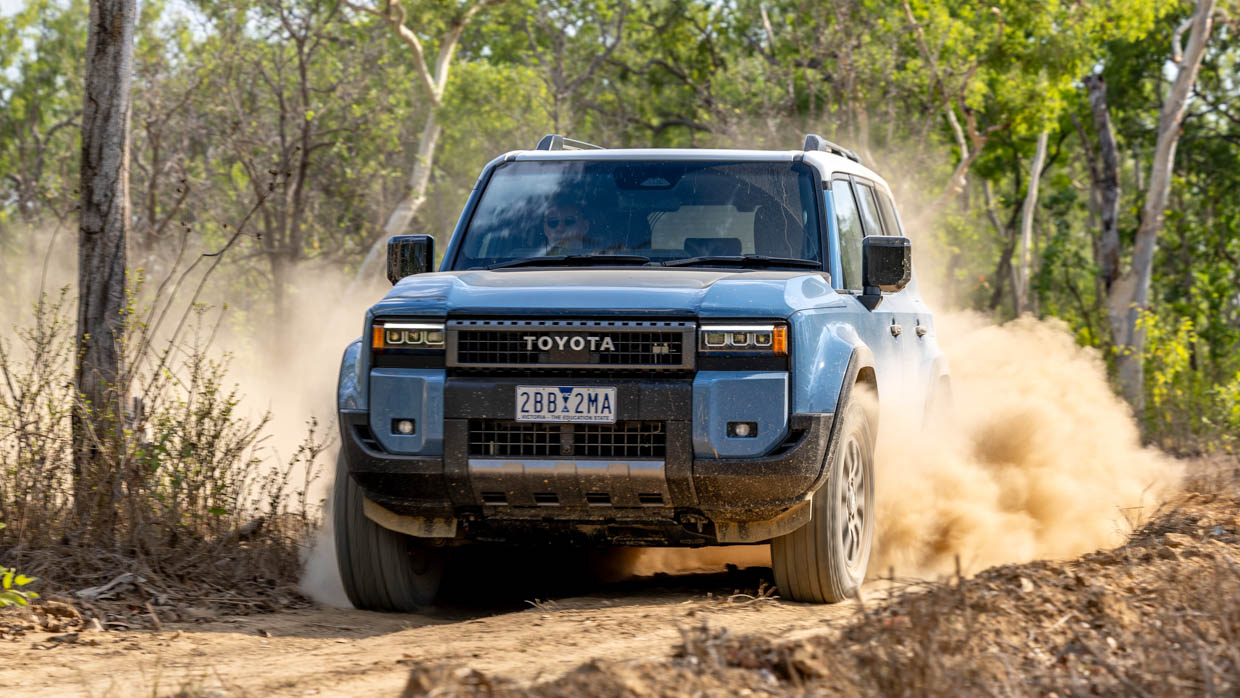
Some of the bullying’s justified. There’s its higher price, same old diesel engine, smaller fuel tank, AdBlue requirement, decreased payload, short service intervals and daft boot layout. But many critics – including those who’ve not actually sampled one – are jumping on a bandwagon simply to give the new Prado a kicking.
Sadly, that’s meant much of what’s very good about the new 250 has got lost in the noise. I’ve twice now driven a retired Prado 150 back-to back with a 250. The new car’s composure, steering response, cabin quiet and smoothness are leaps and bounds ahead, while its cabin – especially the dashboard and controls – make the old car feel veritably Stone Aged.
Yes it’s pricier. But what the hell isn’t these days? The roughly $10k premium over the outgoing Prado 150s is a tough swallow (the range starts from $79,990), but Toyota Australia’s already shifted 20,000 of these newbies. Many Aussies can clearly tolerate the price bump.
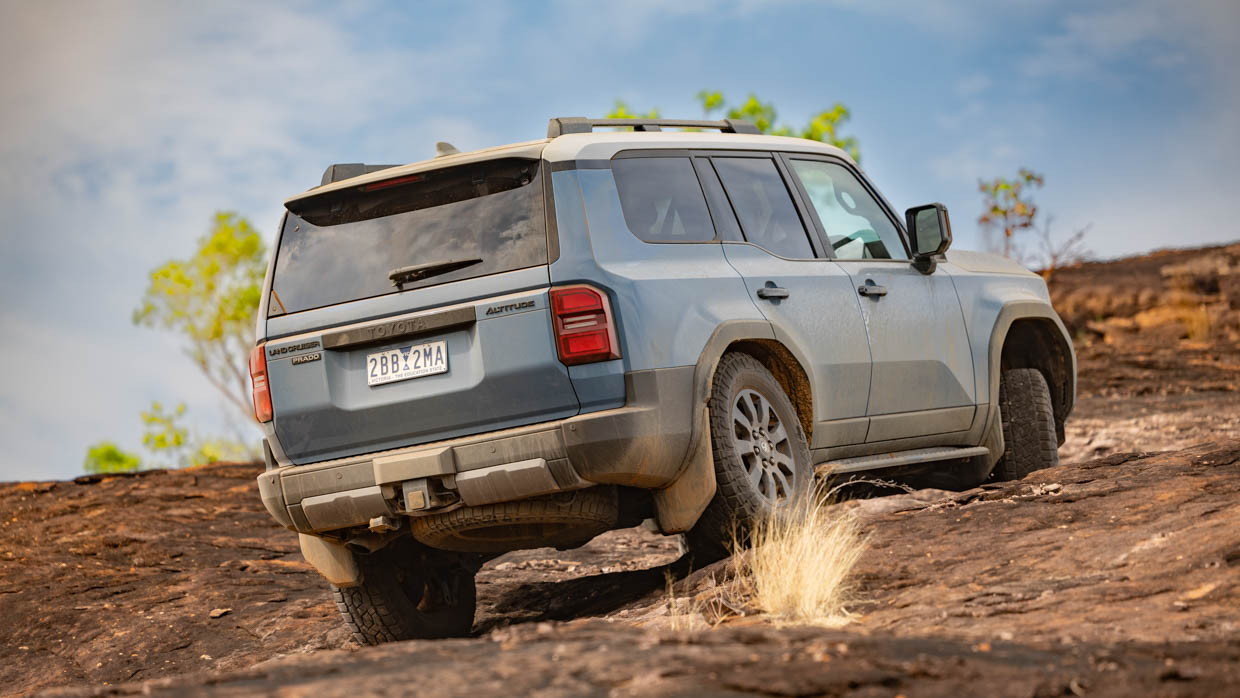
For an overall Prado review, jump into our launch report, or our twin test between the Prado 150 GXL and 250 GXL. Here we’ll focus solely on the $92,700 (before on-roads) Altitude grade – a debuting off-road focussed trim – and why you should and shouldn’t consider one.
First, the good. Aesthetically, it’s the one you want on the driveway. It’s got some of the kit hard-core off-roaders would typically dash to the aftermarket for, particularly 18-inch matte grey alloy wheels with Toyo Open Country all-terrain tyres.
It tows 3500kg, is full-time 4WD, and like the Prado VX and Kakadu has 221mm ground clearance (GX/GXL are only 210mm). It’s the only Prado to boast a rear electrical diff lock (to go with a Torsen locking centre diff), plus a stabiliser disconnection mechanism for better off-road articulation. So it has plenty of solid off-road chops.
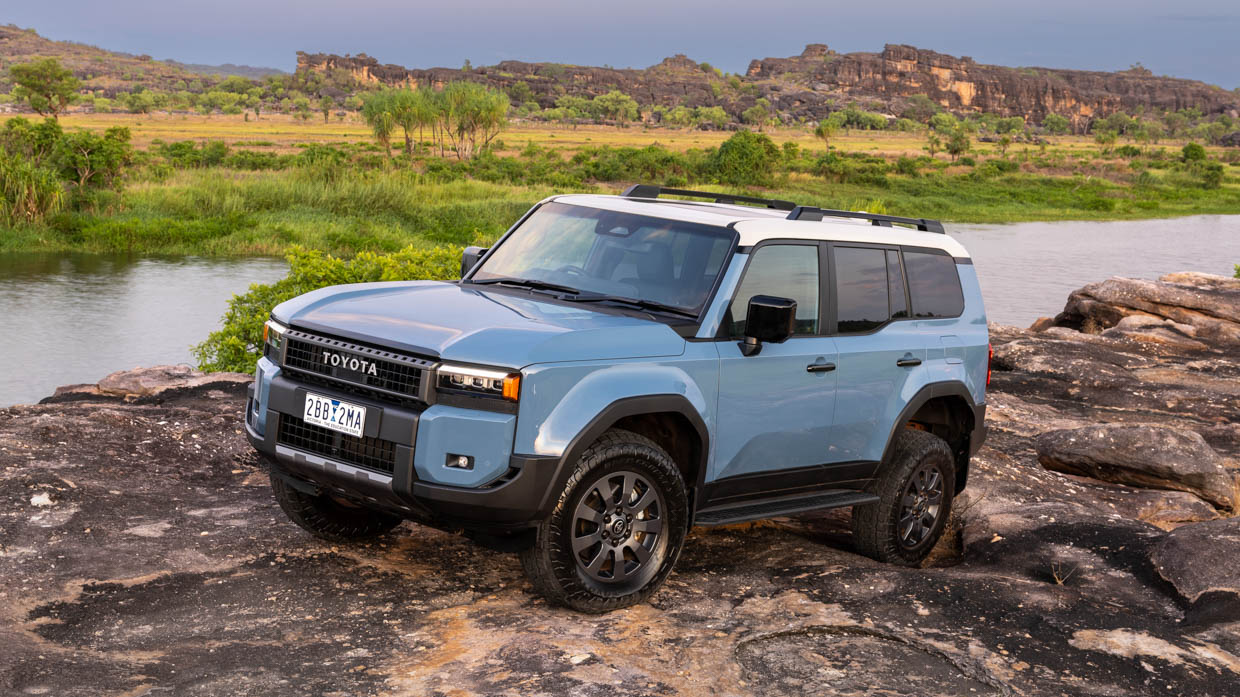
Other wins include a digital rear-view mirror – a must for those who’ve loaded the rear and blocked the glass. There’s an interior tailgate light to illuminate your boot swag, while you get a heated steering wheel for those chilly alpine mornings.
Altitudes score the more retro-cool egg crate grille with big TOYOTA lettering, and while its rectangular lights housing triple LED squares and LED daytime running light strip are character-packed, if ever a model demanded the round headlights gifted to other Prado markets, it should be for the Altitude. That’s a big miss there.
It’s the only Prado offered in striking Ningaloo Blue or Tanami Taupe colours with contrast light grey roof. Good luck choosing between them – both are standouts – but you’re stung for an extra $1700.
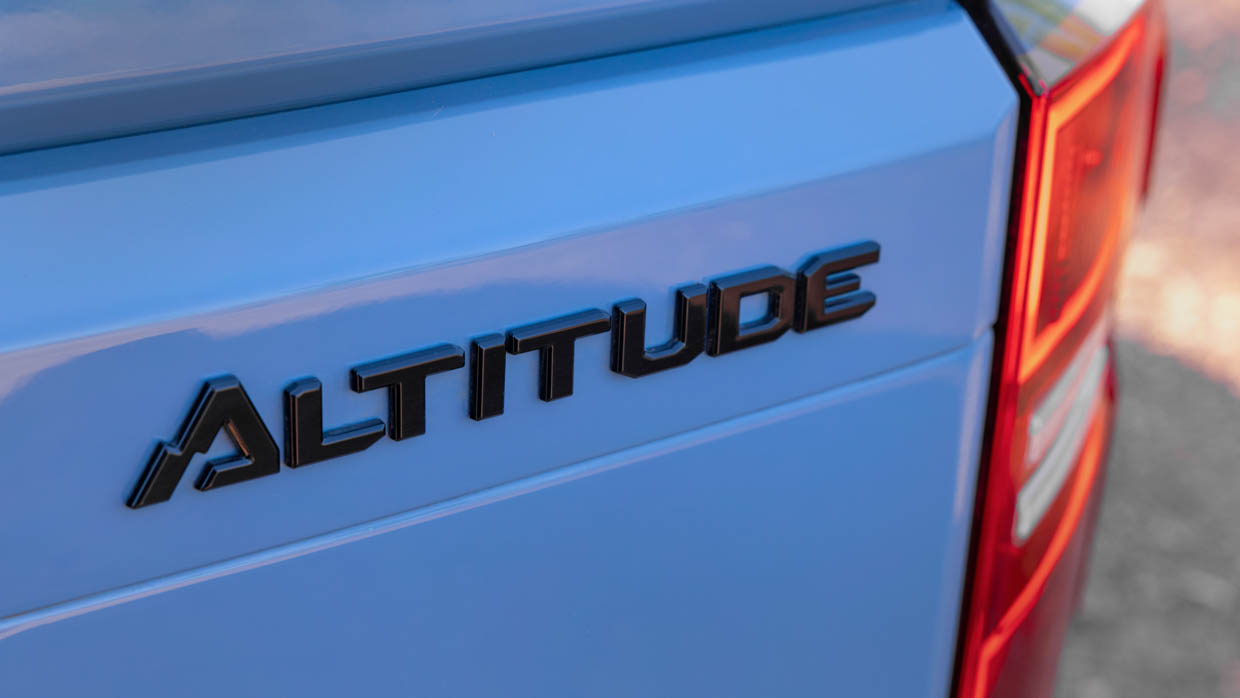
Genuine accessories include a snorkel, nudge bar, bash plate, roof rack, rear recovery points, towing kit, and bespoke Warn-sourced 9000-pound winch sitting behind the number plate. Both alloy and steel bull bars are offered, with the latter available in matching body colour. Sling that on a sand-coloured new Altitude and it’s Insta-worthy.
But hang on. Surely, at almost $100k on the road and being the off-roady one, the Altitude should come standard with the likes of bash plates and a tow kit, right?
Which brings us to the negatives. If you’re not off on a bush odyssey in you Altitude, some of these won’t concern you. After all, this grade will be bought by many suburbanites who simply want the ‘look’ and knowledge it’s the most hard-core version offered. See city-dwelling LandCruiser 70 Series owners for additional examples.
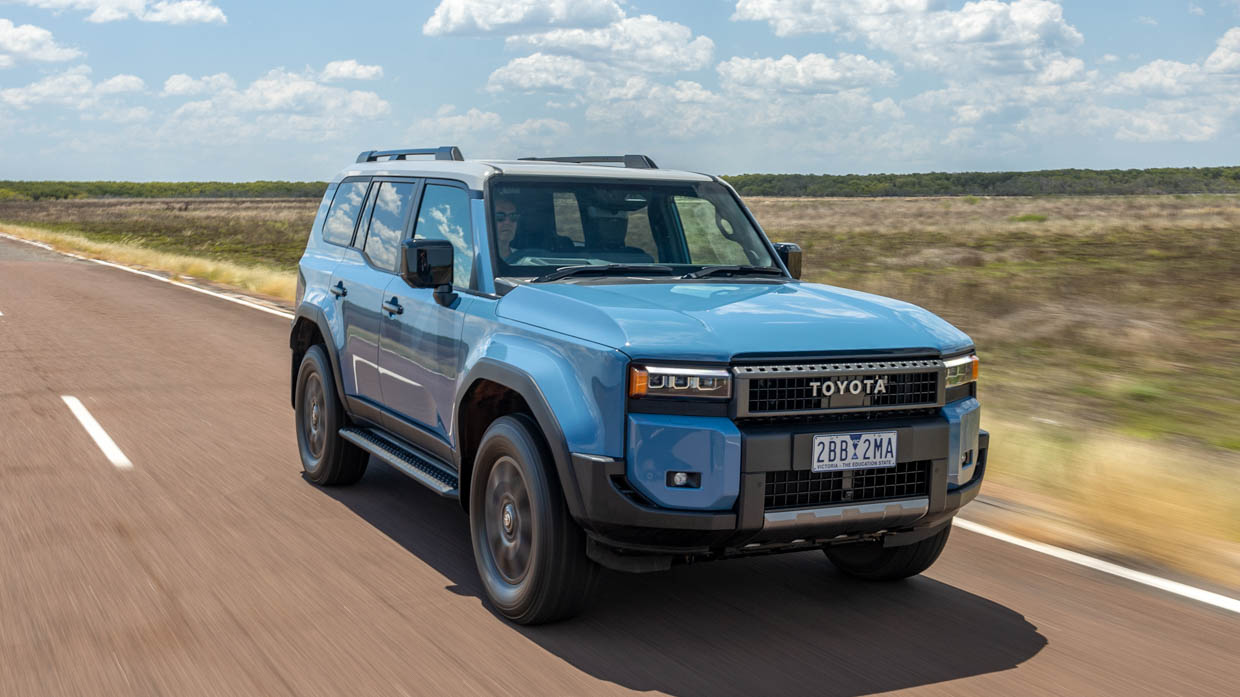
A 110L fuel tank with no obvious space for a sub tank is a concern. The old Prado offered 150L, so let’s hope Santa brought you jerry cans for Christmas if you’re heading remote.
There’s an AdBlue tank too, which needs topped up between services. But it’s really not a hassle. It’s easy to carry AdBlue with you and there’s loads of warning when it’s running low.
But the very fact the car won’t start if AdBlue runs out is psychologically worrying, and AdBlue systems can and have gone wrong on other brands, halting progress. Not popular.
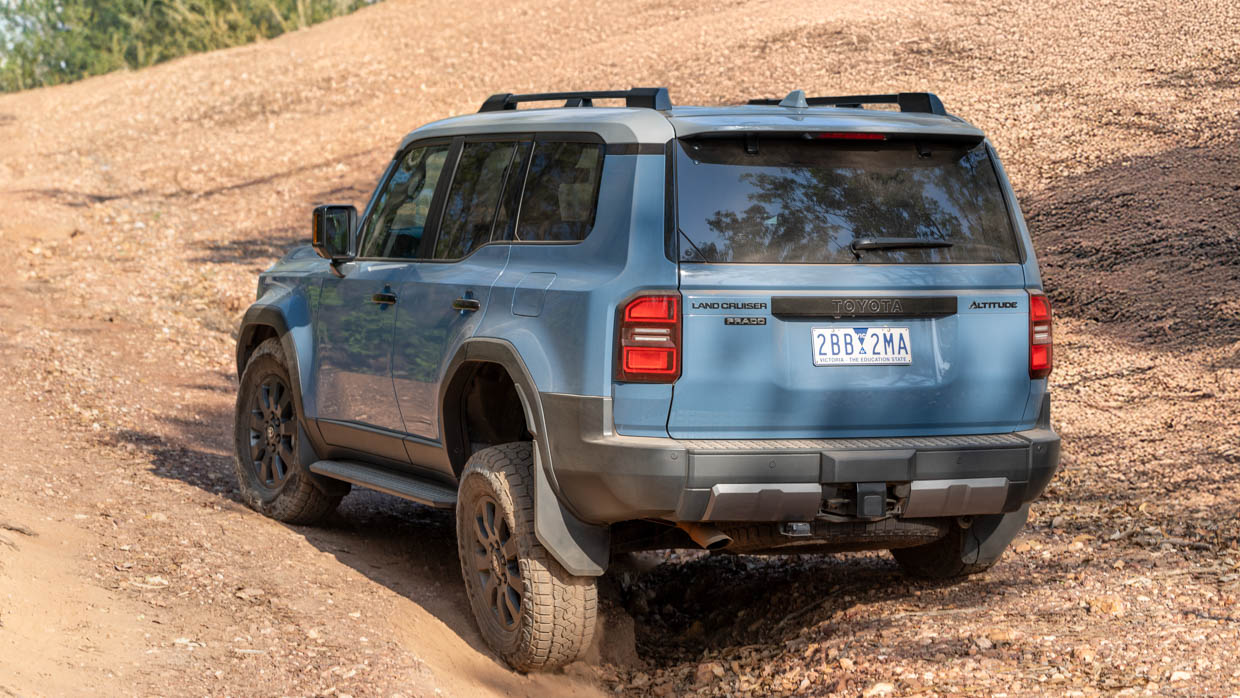
The new Prado’s payload is also down on the old one, and the Altitude’s lumbered with the worst in the range: 580kg with 3100kg GVM. With a 3500kg trailer behind, you’re left with only 230kg payload after deducting the expected 350kg towball download mass. With a couple of larger Australians on board, you best pack very light.
Raise the bonnet – no gas struts by the way – and you’ll not find space for an auxiliary battery. It’s not ideal fitting one in the back either, as the boot’s already a compromise.
It’s a high boot floor courtesy of the spare wheel being under the vehicle, and space being dedicated to the hybrid gubbins required for the petrol hybrid Prado found in other markets. Why should our diesels suffer when Aussie Prados don’t need this hybrid stuff? Let’s hope Toyota Australia’s working on a solution, and fast.
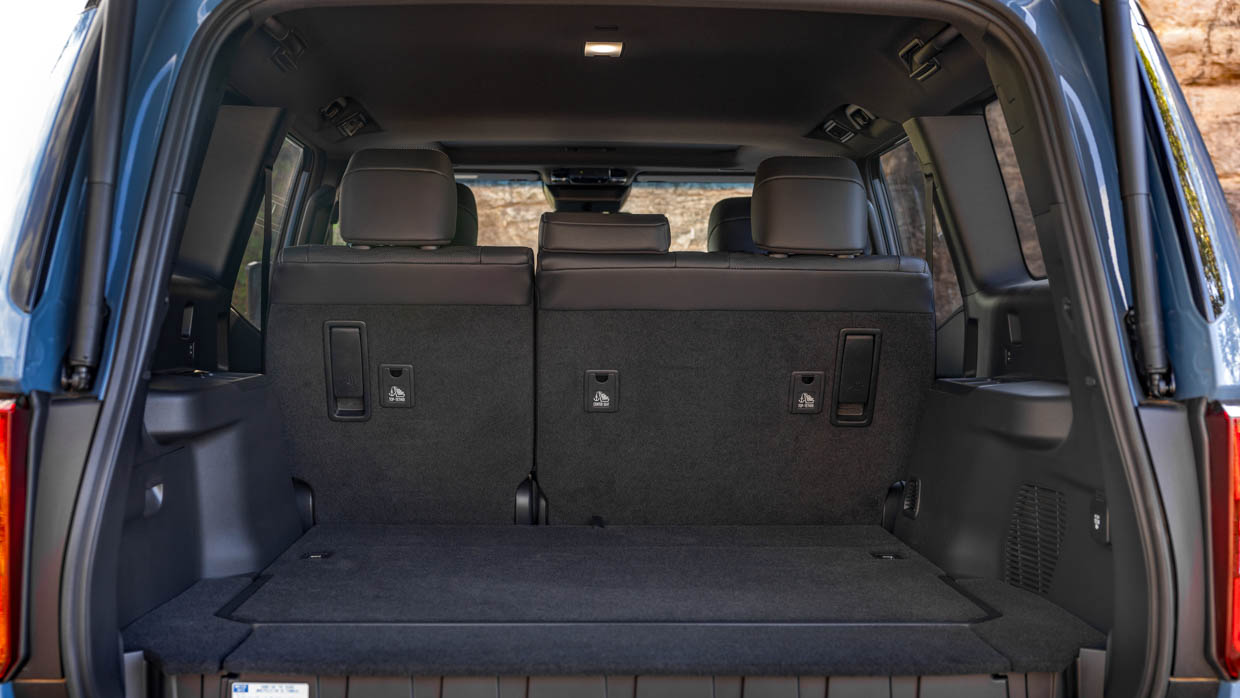
The old Prado’s side hinge tailgate with spare wheel attached is gone, and personally I prefer the top hinge power tailgate. Its glass can cleverly open separately to make for quicker loading into the boot.
It offers a solid 954L to the roof, while four tie-down points and a 100W power point are wins, plus the boot floor can be lifted to hide valuables or to separate dirty equipment.
But the boot floor segments are a fiddle and feel a bit flimsy Reject Shop, rather than robust off-road kit. The seven-seat Prado version’s plastic cup holders and USB ports still exist in this five seater, again pointing at sub-optimal packaging.
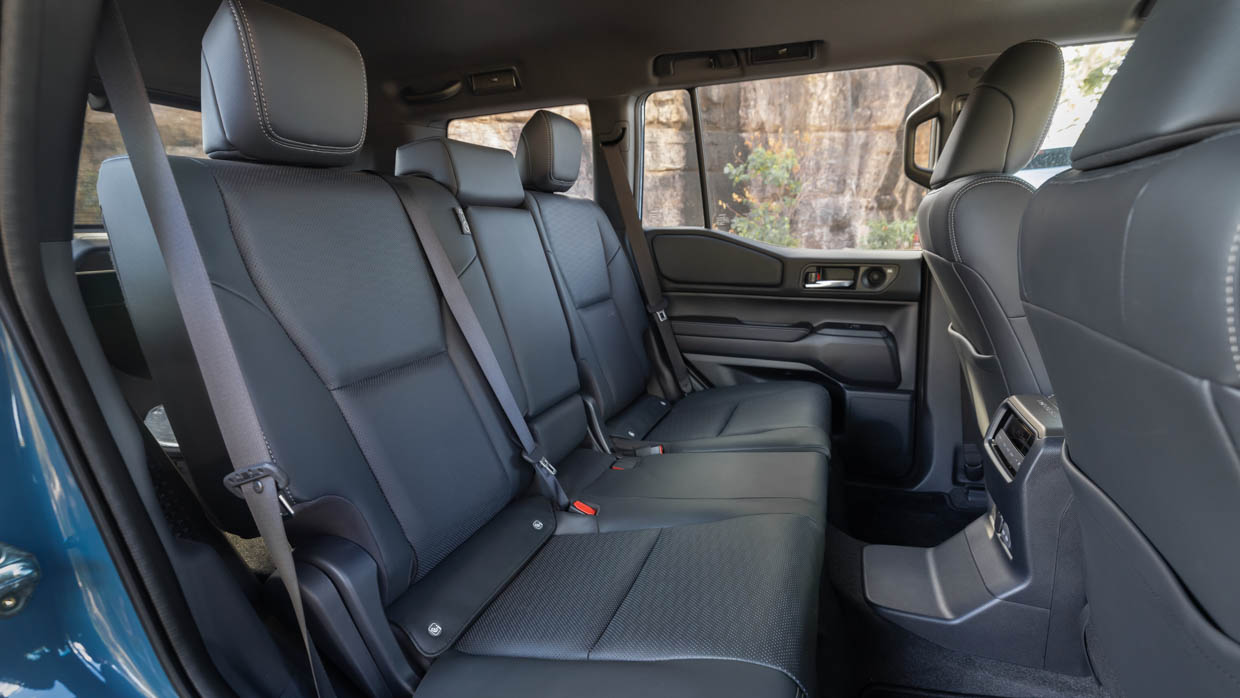
While I’m putting the boot in, Toyota’s hardly made best use of cabin opportunities either. The wheelbase is stretched 60mm over old to 2850mm, so while rear legroom’s really good, not being able to slide the second row back and forward’s a miss. They do, however, tumble forward to allow sizeable cargo space.
Front storage is only average, with a surprising lack of cubbies for such a large SUV. The massive gear shifter looks out of place in these times of space-saving rotary gear selectors. The Altitude scores a refrigerated box under the centre armrest, but it’s a tiddler, so make sure your lunch is light.
Otherwise, the Altitude’s cabin is seriously classy. Part-leather trim feels superb, quality and robust. We tackled many hours of on- and off-road travel and seat comfort was standout.
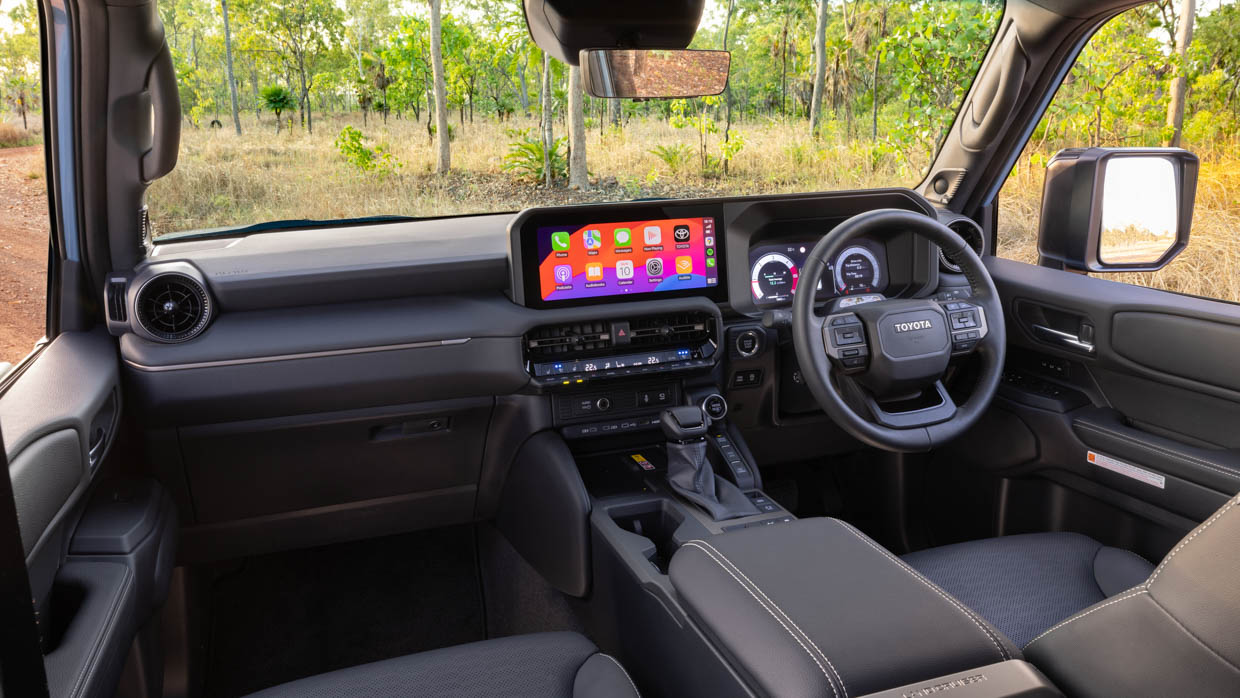
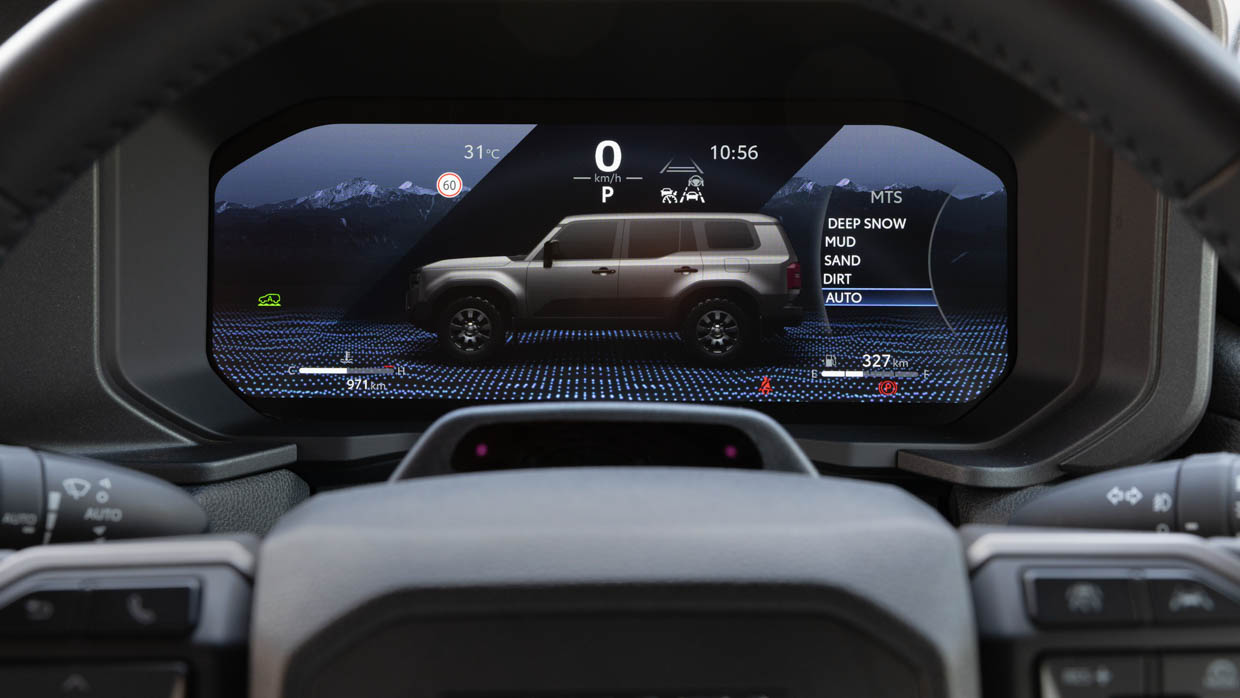
Those embarking on lengthy travels shouldn’t be disappointed. There’s heated and ventilated power seats, power steering column, head-up display, 12.3-inch digital driver display and 12.3-inch infotainment touchscreen. It presents superbly well and feels bang up to date.
There’s embedded and cloud-based sat nav, wireless CarPlay and Android Auto, wireless charging, five USB-C ports, an HDMI port and JBL audio. This is far from a stripped-out bush basher. There are even carpet floor mats, which lost their appeal after tramping wet red mud over them on our test.
So, the drive. Despite no adaptive damping (as found on Prado VX and Kakadu), the ride quality of this ladder-frame SUV is damn good. The frame’s far more rigid than in old Prados, helping the drive feel tight, controlled and safe.
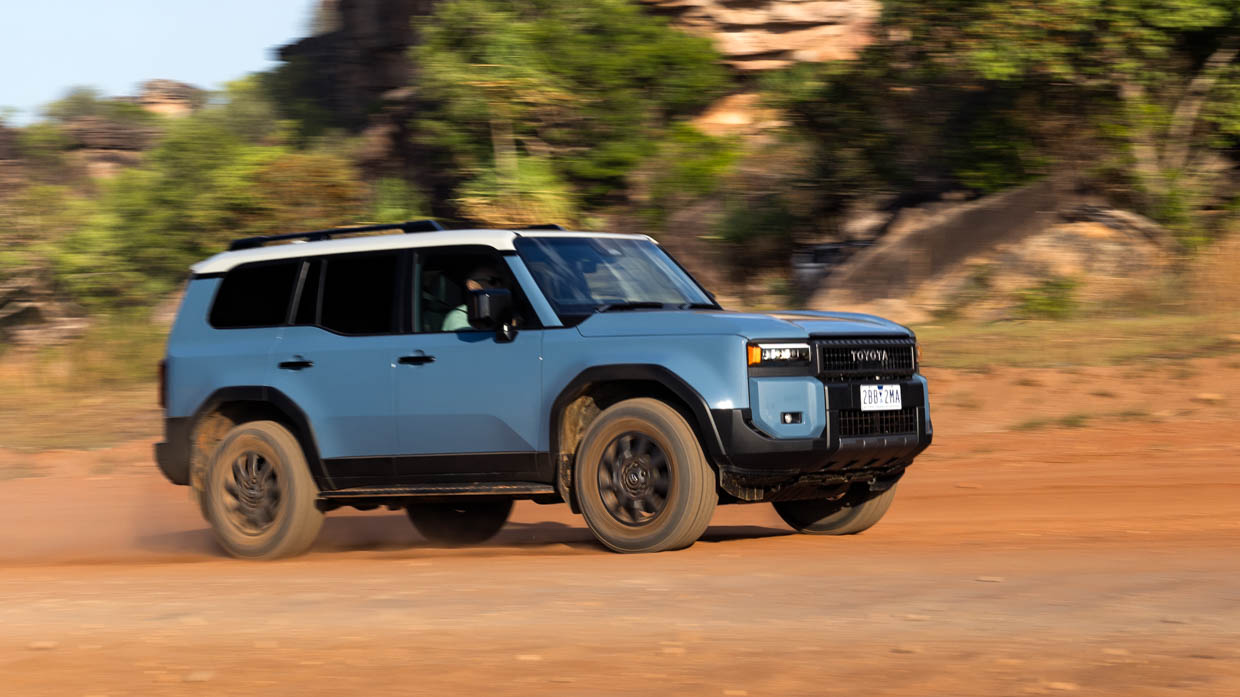
Yes, it still jitters around on choppy urban roads and there’s a dose of body lean in corners, but I’d rather live with one as a daily than the bouncier Ford Everest rival. The Prado is the more settled big SUV.
I was expecting the Altitude’s all-terrain rubber to be a sticking point on the sealed stuff, but so well insulated is the Prado’s cabin that road noise is barely worth mentioning. Handling remained solid and safe in the dry, but we never managed to try this rubber on a wet sealed road, which would be a sterner test.
The new Prado’s electric power steering’s standout, proving light and easy at low speeds, then firming up with reasonable response at higher speed.
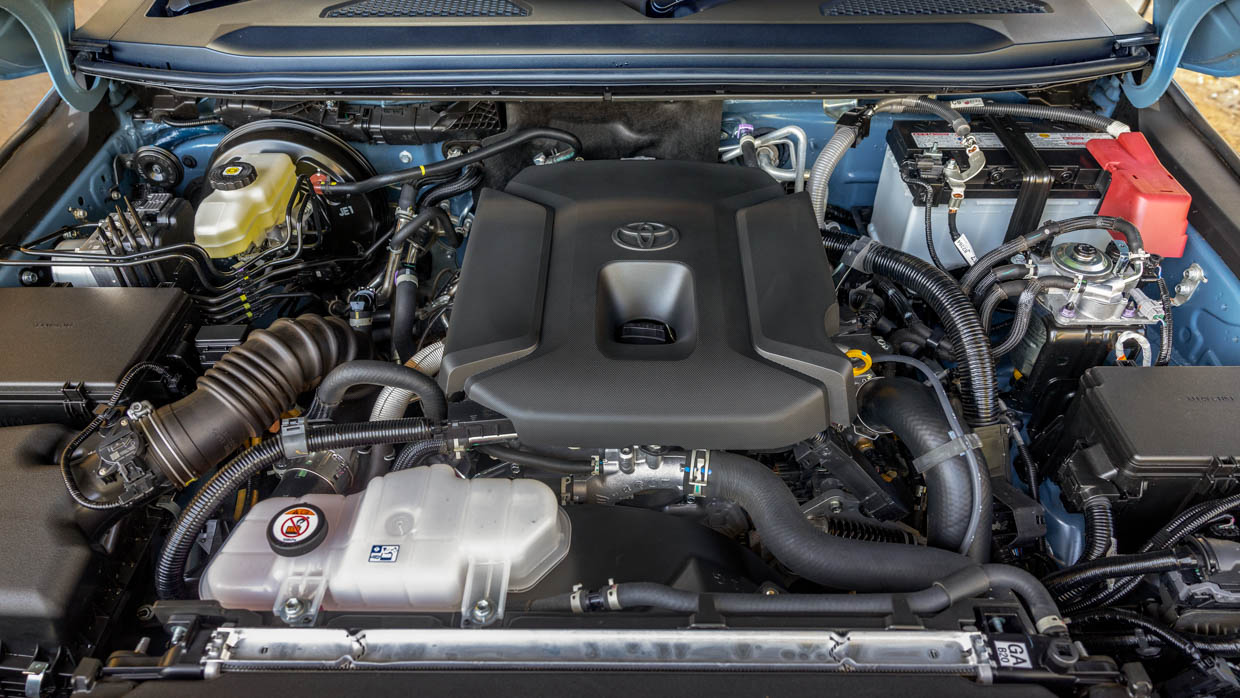
Most impressive was over dirt tracks, which feel like the Altitude’s happiest stomping ground. Feel and roadholding are excellent, and good grief the brakes and ABS do a superb job of calmly hauling this thing to a quick stop.
A V6 diesel or the USA’s 243kW/630Nm 2.4L turbo four-cylinder hybrid would give the Altitude a bit more to boast about in the trouser department. Either would bring a lot more kudos to this new edition to spark the interest of the more hardcore 4×4’er.
The same old (but improved) 2.8-litre four-cylinder turbo-diesel with 150kW and 500Nm is a pragmatic but expected choice, and feels smoother and more responsive courtesy of a new eight-speed auto and 48-volt assistance.
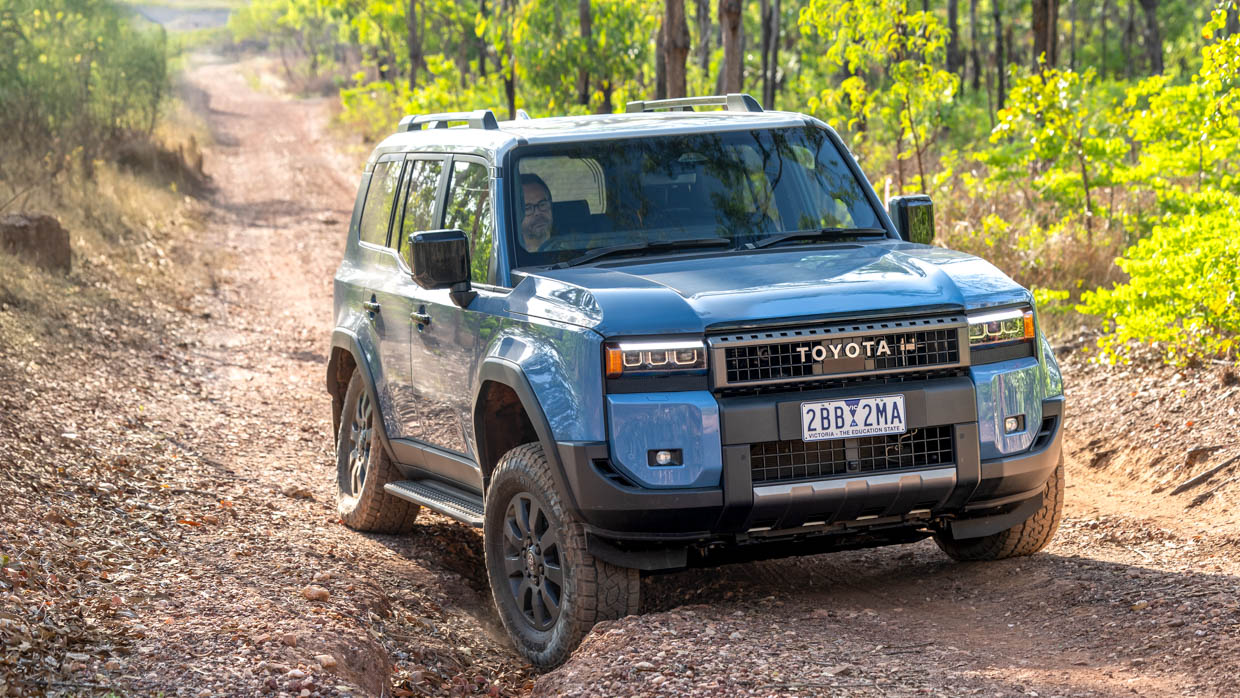
In truth, what matters more is how it and the Altitude perform off-road. Our launch review details the new Prado range’s superb bushability, but the Altitude ups the ante in terms of comfort and capability due to its extra features.
A stabiliser disconnect mechanism (SDM) allows wheel articulation approximately 10 per cent greater than the old Prado with Kinetic Dynamic Suspension System (KDSS) fitted.
We tried it over a rocky hill climb of around 35-degrees, simply operated with a centre console button. It, like moving into low range, is a silky, clunk-free job.
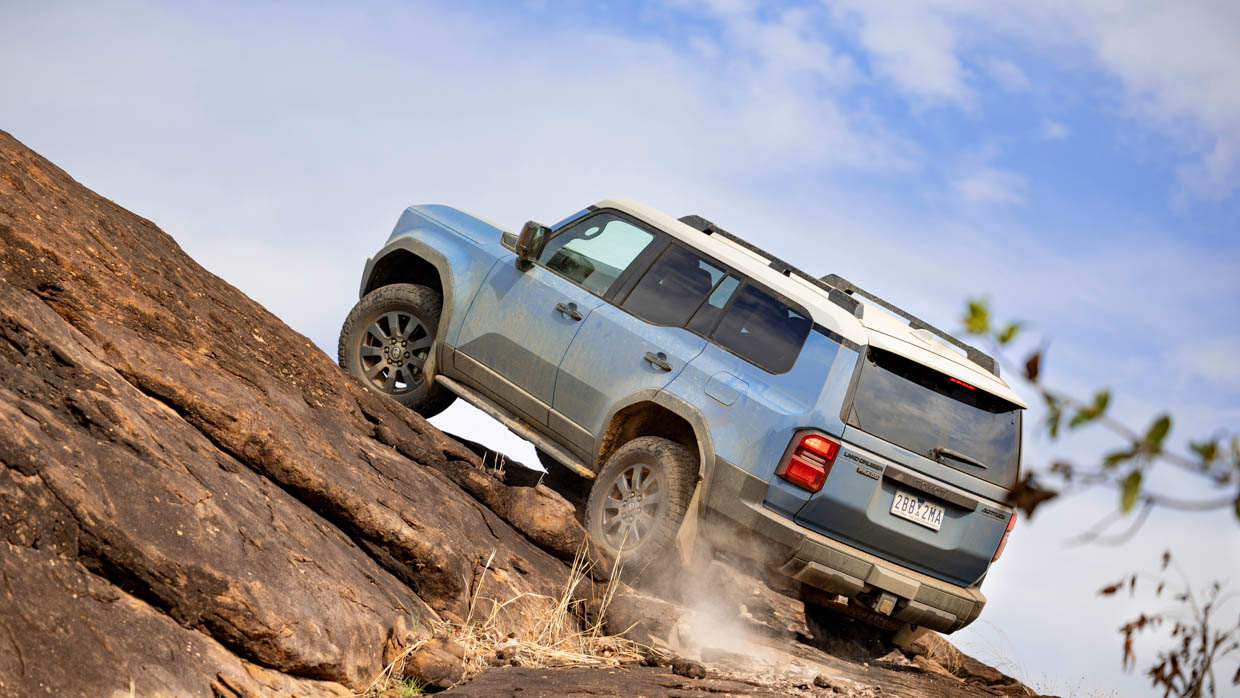
The SDM boosts traction at the front axle, while rear-wheel grip’s helped by engaging the rear diff lock, which also quickly engages on request.
To be honest, the Altitude walked our rock course; the articulation excellent and traction superb, as it also proved over a slippery mud course and deep-ish water wade. We wanted to explore further, but the nature of new car launches restrict deviation from planned routes.
Seriously hardcore off-roaders would need to go deep to truly test its limits, but with all the tech engaged and those 265/70R18 Toyo Open Country tyres, for our test the Altitude soared. Everything’s relative, but I’d suggest the vast majority of Aussie off-roaders wouldn’t take their Prados over anything gnarlier than our routes.
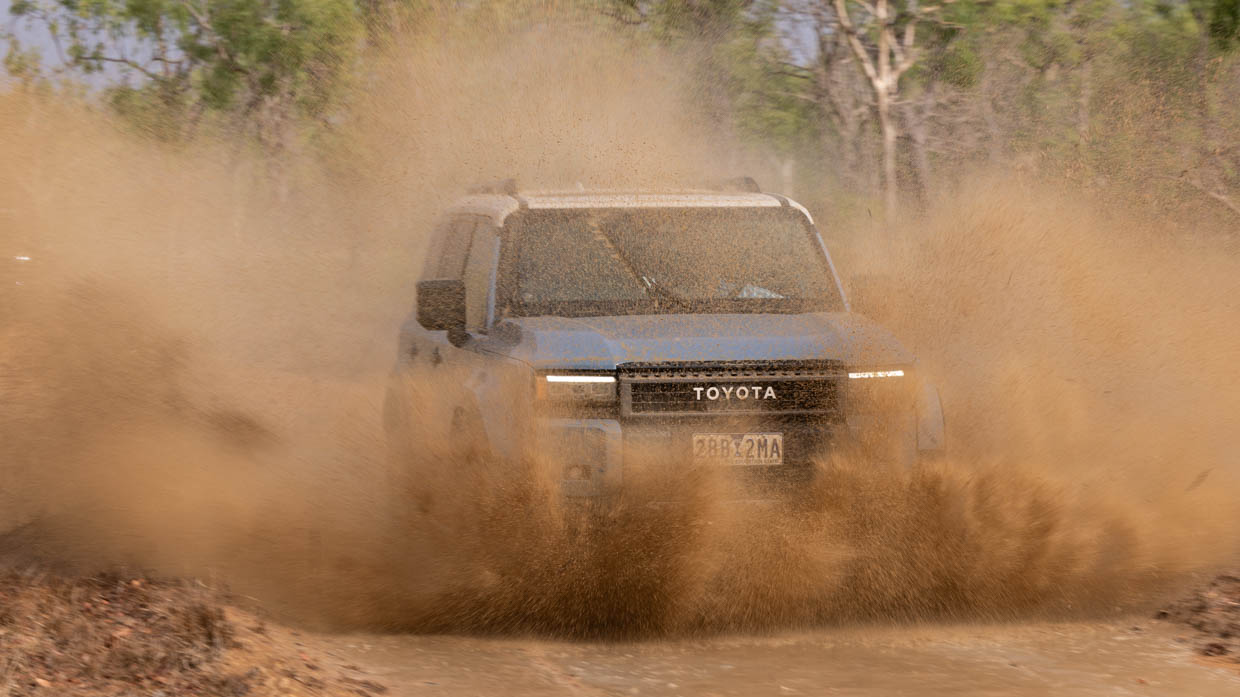
There are so many smarts at work. It offers five drive modes in 4H (mud, snow, dirt, sand auto), and the same in 4L bar the dirt mode. There’s also Crawl Control with five different crawl speeds, and this literally makes things point and shoot.
For our steep rock climb and descent, I tried the lowest crawl speed and the Altitude calmly walked it. The car builds torque on a particular wheel as it detects obstacles, applying just the right amount to pick a path through.
It can also brake each individual wheel, so there’s an overwhelming lack of anxiety during the whole process as it practically does all the thinking for you. While chilling in ventilated seats, it’s easy to forget the Altitude’s in fact being a four-wheeled mountain goat.
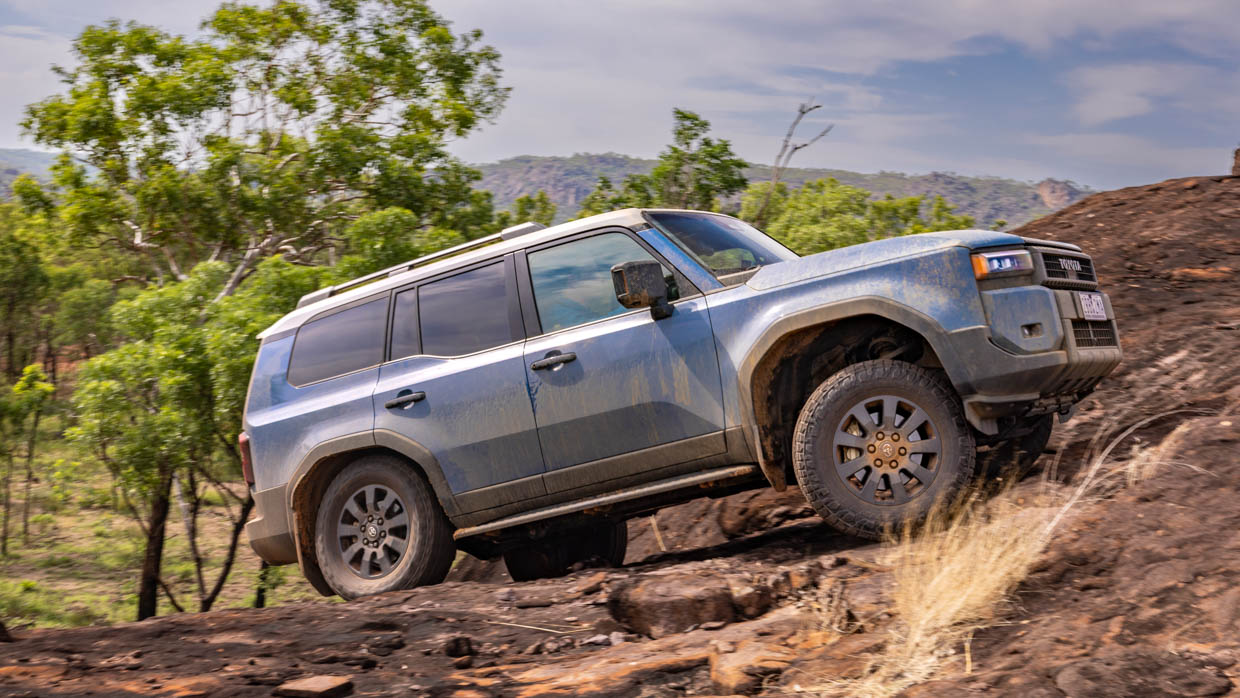
Another boon is the Multi-Terrain Monitor. You score 360-degree cameras, plus an underfloor view giving the driver a composite view of what lies beneath. This is next-level helpful when navigating deep ruts or large rocks, while if you’re pointing up with just sky through the windscreen, a lower camera shows the road view through your dash screen.
With the new Prado’s larger, lower windows and more upright windscreen, off-road visibility through the glass is also excellent. There are knee pads against the centre console, while the electric power steering means much less steering wheel kick-back when bouncing between obstacles.
Turning off all the driving aid sensors for tight off-road paths is more of a faff. A simple solid button by the steering wheel would be preferable to diving through screen menus.
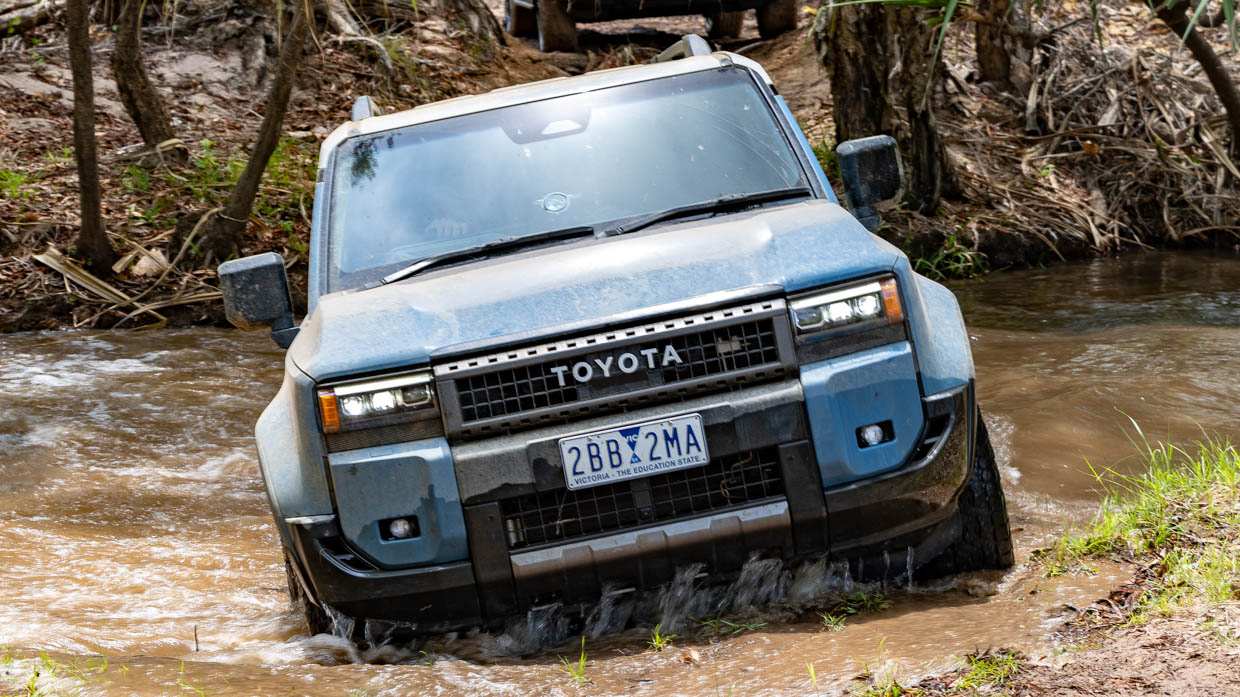
To be honest, my test of non-Altitude Prados also left me gob-smacked with their abilities. So good are the traction control system and drive modes, it feels if you put a decent set of all-terrains on any new 250 and you’d be unlikely to get in much trouble. But the Altitude just brings that next level of adventuring surety.
Cruising along the Northern Territory’s 130km/h speed-limit roads on the Altitude’s knobblier rubber, and it didn’t feel like much of a sacrifice over highway tyres. The noise was hardly noticed, especially with the solid JBL audio pumping.
You build respect for a vehicle on trips like this, and the Altitude is an overall brilliant all-rounder. Capable, comfortable, well equipped and surprisingly good fun to drive over every terrain we sampled. I respected the old Prado 150, but I never wanted to live with one as much as I do this retro-styled 250.
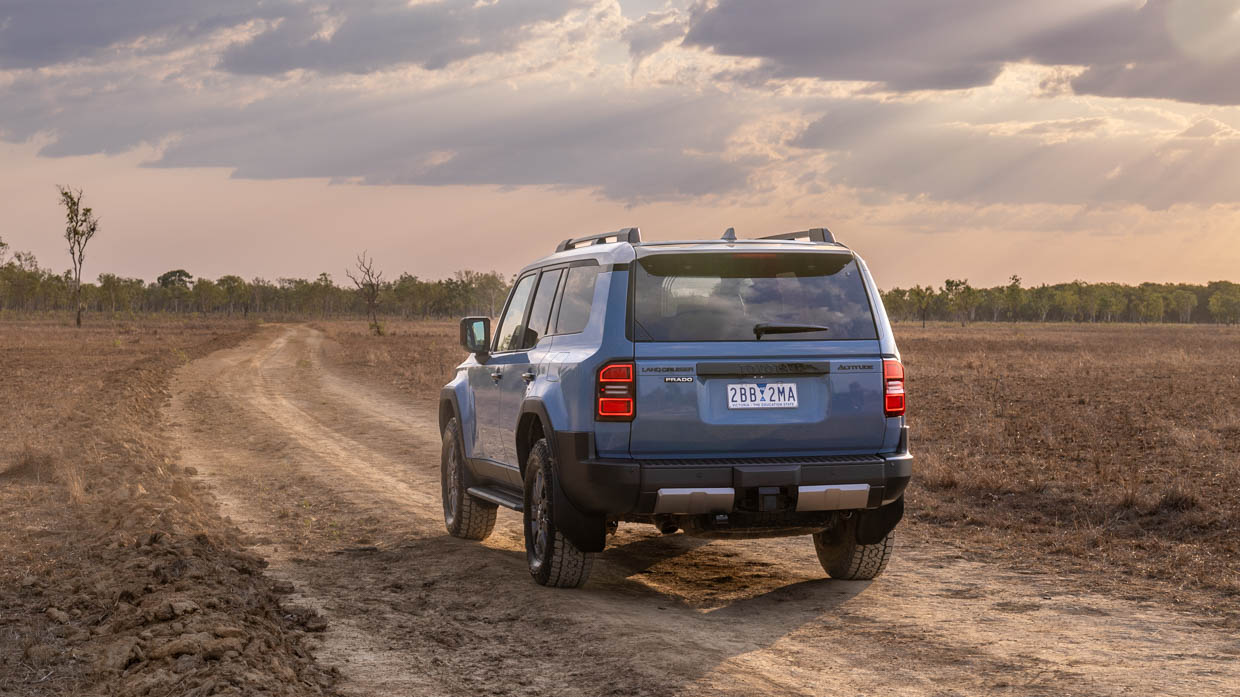
It’s far from perfect. The aforementioned compromises and a few silly own goals prevent this Prado Altitude (and all Prado 250s) being an absolute standout. But it’s still a bloody good 4×4 and a bloody good Prado, and must be driven to be appreciated.
Is the Altitude grade worth the extra coin? If you’re serious about adventuring, or have simply fallen for its rugged looks, absolutely it is. It’s ready to cross the country out of the box in a way no other Prado has ever been. But only if you carry enough fuel and a bottle of AdBlue, of course.
Key specs (as tested)
About Chasing cars
Chasing Cars reviews are 100% independent.
Because we are powered by Budget Direct Insurance, we don’t receive advertising or sales revenue from car manufacturers.
We’re truly independent – giving you Australia’s best car reviews.
The estimate provided does not take into account your personal circumstances but is intended to give a general indication of the cost of insurance, in order to obtain a complete quote, please visit www.budgetdirect.com.au. Estimate includes 15%^ online discount.
^Conditions Apply
Budget Direct Insurance arranged by Auto & General Services Pty Ltd ACN 003 617 909(AGS) AFSL 241 411, for and on behalf of the insurer, Auto & General Insurance Company Limited(ABN 42 111 586 353, AFSL 285 571).Because we don’t know your financial needs, we can’t advise you if this insurance will suit you. You should consider your needs and the Product Disclosure Statement before making a decision to buy insurance. Terms and conditions apply.
Indicative quote based on assumptions including postcode , 40 year old male with no offences, licence suspensions or claims in the last 5 years, a NCD Rating 1 and no younger drivers listed. White car, driven up to 10,000kms a year, unfinanced, with no modifications, factory options and/or non-standard accessories, private use only and garaged at night.
^Online Discounts Terms & Conditions
1. Discounts apply to the premium paid for a new Budget Direct Gold Comprehensive Car Insurance, Third Party Property Only or Third Party Property, Fire & Theft Insurance policy initiated online on or after 29 March 2017. Discounts do not apply to optional Roadside Assistance.
2. Discounts do not apply to any renewal offer of insurance.
3. Discounts only apply to the insurance portion of the premium. Discounts are applied before government charges, taxes, levies and fees, including instalment processing fees (as applicable). The full extent of discounts may therefore be impacted.
4. We reserve the right to change the offer without notice.